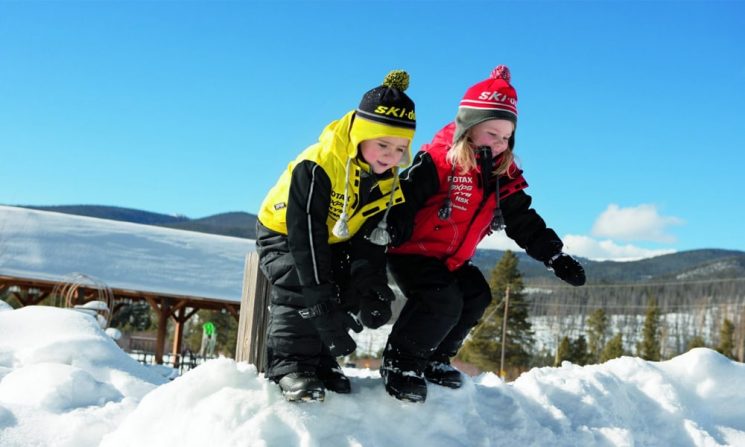
At Sports DRC, many clients ask us about regulations regarding children snowmobile passengers. Opinions and comments dominate the g9lobal discussion and we thought you might be interested in knowing what the regulations really are! To shed some light on everyone’s safety, we met with Officer Éric Larouche of Sûreté du Québec.
Are you really allowed to have a passenger?
First of all, the instruction manual provided by the vehicle’s manufacturer must allow two passengers on the snowmobile. For example, on Ski-Doo snowmobiles, the original one-person seat does not allow you to carry a passenger, but you can with a 1 + 1 seat.
Ready to go?
It is strictly forbidden to have a passenger in front of you. For some, this position seems more secure, but in the case of an impact, your body will be thrown forward and you will most likely crush your child. That is why your passenger must be seated behind the driver. The passenger must have three support points: the backrest, hands on the handles and feet well supported by footrests. That is how you will be sure of safely carrying your child. If they are not tall enough to rest their feet on the footrests, they shouldn’t be a passenger on your snowmobile. Workshop-manufactured footrest adaptors added atop the original footrests are generally tolerated by police officers.
Why is it so important for the footrests to be of appropriate height? Your passenger must be able to rest their feet when you are performing maneuvers with your snowmobile. During a tight turn, a child can quickly fall out of the vehicle if they are not appropriately supported. At an early age, children tend to fall asleep during snowmobiles rides. A safety harness, like the one designed by Bilodeau, keeps the child in place on the snowmobile. However, the harness does not serve as a substitute for appropriate footrests. Your child’s feet must be supported at all times, with or without a harness.
What about a carriage trailer?
It is permitted to carry your children in a carriage trailer attached behind your snowmobile. It must be equipped with two reflectors in the back and two on the side facing the back. It must also have a central rear light that lights up when you brake. The carriage trailer must have a rigid hitching device. No rope! Commercially available carriage trailers normally meet the required security standards. If you have any doubts on the safety of your carriage trailer, you can contact your local police station and have your equipment checked by a police officer. (Similarly to the validation of a child seat in a car.) It is not mandatory for passengers to wear a helmet in the carriage trailer if it has a closed cabin. Nonetheless, for increased security, it is strongly advised to do so.
What about my teenager? Can I lend him or her my snowmobile?
The minimum age for driving alone is 16. Your teenager must hold a certificate of competency or a valid driver’s license (including class 6D for moped). Without that, they will not be allowed to cross roads. After the age of 18 years, it is no longer necessary to have a driver’s license or a valid certificate to drive a snowmobile. However, without a driver’s license, the driver cannot cross roads that are used by cars, even if they are 18 years of age. If your child is pulled over by the police while violating the rules, you, as the parent, will most likely be held responsible for the offense. The penalty for this type of offense is $500 plus fees!
The helmet
Whenever a driver and a passenger are seated on their vehicle, they must be wearing a certified helmet. Whether you are on a provincial trail or on your own land trying to clear your entrance, you must be wearing your helmet. All passengers of a snowmobile must, at all times, wear a helmet.
From what age can a child wear a helmet?
There is no regulation governing the minimum age to wear a helmet. Passenger and driver must wear a helmet at all times. However, according to the Canadian Paediatric Society, a child under 6 years of age doesn’t have the strength and endurance to be a passenger in a snowmobile. If you do decide to go snowmobiling with your child under 6 years of age, it must have all three supporting points mentioned earlier in this article, and, of course, wear a helmet.
Outside of provincial trails, am I still governed by the same laws?
Off-road vehicle regulations (snowmobile, ATV and side-by-sides) are applicable everywhere, including on private land, in the forest, at your cottage and on a provincial trail.
And finally…
In collaboration with Officer Éric Larouche, we would like to take the opportunity to make a few safety reminders whether you are alone or accompanied on your snowmobile:
-Bring a photo ID proving your age, your vehicle registration, your certificate of insurance and your provincial trail permit.
-The original license plate is mandatory and must be visible on the vehicle … not in your trunk! A reproduction of your license plate on the tunnel is not valid.
-If a provincial trail going to your destination exists, you are obligated to use it. You cannot be riding on any private property. Arrangements are made each year with the landowners to offer rights of way and allow you to practice your passion.
-Your snowmobile must have a mirror on the left.
-Your judgment is essential on a snowmobile, for your safety and that of others. Enjoy the pleasures of alcohol at the end of your day, after you return from your ride. Driving a snowmobile while impaired by alcohol, drugs or medication is prohibited. In case of an offense, the sanctions that apply are the same as for any other driver.
Finally, snowmobiling is a fun sport that allows us to explore new spaces and to enjoy pleasant moments with friends and family! By using your common sense, you protect those you love and those you meet along the way. Have fun! There are still a few beautiful weeks to the winter!

